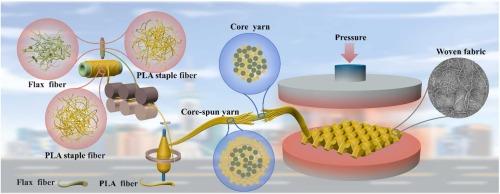亚麻纤维和聚乳酸纤维在包芯纱中的分布对生物质基复合材料性能的影响
IF 6.2
1区 农林科学
Q1 AGRICULTURAL ENGINEERING
引用次数: 0
摘要
天然纤维增强复合材料具有轻质、可降解和优异的力学性能等优点。本工作的主要目的是研究增强纤维和基体在复合材料中的分布对复合材料性能的影响。利用聚乳酸(PLA)纤维的热塑性,将亚麻油纤维与聚乳酸(PLA)纤维制成包芯纱织成织物进行热压制备生物质基复合材料。包芯纱采用包芯-护套结构,包芯纱为亚麻/聚乳酸混纺纱,护套部分为聚乳酸短纤维。特殊的结构有效地提高了纱线的毛羽度、均匀度和织性。通过控制聚乳酸和亚麻纤维在包芯纱和包芯纱中的分布,改善增强纤维和基体的分布,从而提高复合材料的性能。当PLA与亚麻纤维的共混比为80:20时,复合材料具有优异的拉伸性能(断裂强度为32 MPa,伸长率为14.3 %)、撕裂性能(撕裂能为95.71 KJ/m2)和动态热力学性能(35℃下储存模量为1953 MPa,损耗系数为0.285)。此外,复合材料表现出优异的环境友好性,180天内的生物降解率为52.1% %。在这项工作中开发的这些生物质基复合材料在汽车内饰,运动器材,包装材料等方面显示出令人钦佩的潜在应用。本文章由计算机程序翻译,如有差异,请以英文原文为准。

The effect of flax and PLA fibers distribution in core-spun yarn on the properties of biomass-based composite
Natural fiber reinforced composites possess the advantages of lightweight, degradability and excellent mechanical properties. The primary objective of this work was to investigate the effect of the distribution of reinforcing fibers and the matrix within the composite on the performance of composites. The biomass-based composites were prepared by hot-pressing the fabrics woven by core-spun yarn that produced from flax noil fibers and Polylactic Acid (PLA) fibers, utilizing the thermo-plasticity of PLA fibers. The core-spun yarns were constructed with a core-sheath structure, in which the core yarn was a flax/PLA blended yarn and the sheath part was PLA staple fibers. The special structure effectively improved the hairiness, evenness and weave-ability of the yarn. The properties of the composites were improved by controlling the distribution of PLA and flax fiber in the core and sheath of the core0-spun yarn in order to improve the distribution of the reinforcing fibers and matrix. The biomass-based composites presented the excellent tensile properties (breaking strength of 32 MPa, elongation of 14.3 %), tearing properties (tearing energy of 95.71 KJ/m2) and dynamic thermo-mechanical properties (storage modulus of 1953 MPa at 35℃ temperature, loss factor of 0.285), when the blending ratio of PLA and flax fiber within the core yarn was 80:20. In addition, the composites showed superior environmental friendliness, with a biodegradability of 52.1 % within 180 days. These biomass-based composites developed in this work display admirable potential applications for automobile interiors, sporting equipment, packaging materials, etc.
求助全文
通过发布文献求助,成功后即可免费获取论文全文。
去求助
来源期刊

Industrial Crops and Products
农林科学-农业工程
CiteScore
9.50
自引率
8.50%
发文量
1518
审稿时长
43 days
期刊介绍:
Industrial Crops and Products is an International Journal publishing academic and industrial research on industrial (defined as non-food/non-feed) crops and products. Papers concern both crop-oriented and bio-based materials from crops-oriented research, and should be of interest to an international audience, hypothesis driven, and where comparisons are made statistics performed.
 求助内容:
求助内容: 应助结果提醒方式:
应助结果提醒方式:


